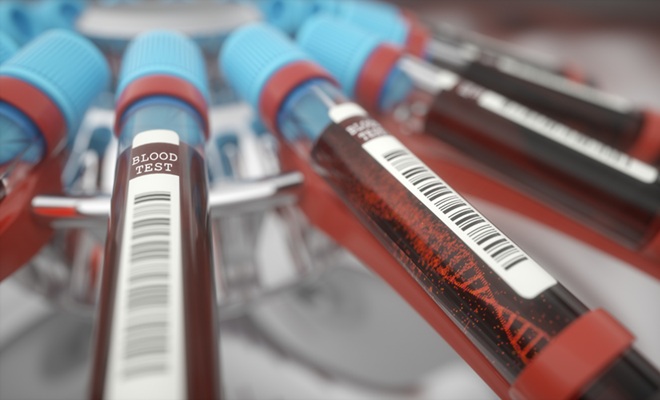Simplified Assay Quantifies Circulating Activated Protein C
|
By LabMedica International staff writers Posted on 24 Aug 2016 |

Image: A histopathology of brain tissue showing acute venous thromboembolism of unknown etiology (Photo courtesy of Peter Anderson).
The protein C (PC) anticoagulant pathway plays a crucial role in the regulation of fibrin formation by inactivating the pro-coagulant cofactors factor Va and factor VIIIa.
The physiological relevance of PC in the regulation of blood coagulation arises from the description of increased risk of venous thromboembolism (VTE) associated with both hereditary PC deficiency and low circulating activated protein C (APC) levels. Available assays for circulating levels of APC are either time-consuming or difficult to use in a routine laboratory, or have a detection limit above normal levels.
Scientists at the Instituto de Investigación Sanitaria La Fe (Valencia, Spain) developed a simplified assay that measures both the in vivo free APC and the in vivo APC complexed to PC inhibitor (PCI). They measured APC levels, with both assays, in 339 plasma samples, 165 from patients with venous thromboembolism (VTE) and 174 from healthy individuals.
The PCI antigens were determined and PCI concentration was expressed in nM, assuming a molecular weight for PCI of 57,000 and a concentration of plasma PCI, in pooled normal plasma, of 87.7 nM. APC: PCI complexes were determined by a sandwich enzyme-linked immunosorbent assay (ELISA). Microplates were coated with a monoclonal antibody to PC and complexes were detected with peroxidase-labeled polyclonal antibodies to PCI. APC concentration in the complex is expressed in nM, assuming a molecular weight of APC of 57,000.
The investigators found that the mean APC level in the 339 samples was 0.038 ± 0.010 nM, using a previous assay that measures only the in vivo APC level, and 0.041 ± 0.010 nM with the present new assay. The mean APC level in VTE patients was 0.034 ± 0.009 nM (previous assay) and 0.037 ± 0.009 nM (new assay), significantly lower than those in controls. In both groups there was a significant correlation between the levels obtained by the two assays.
The authors concluded that their results show that both assays are equivalent, and confirm that the APC level is lower in VTE patients than in healthy individuals. Therefore, the new simplified assay, which measures the sum of circulating free APC and APC complexed to PCI, may be used to estimate the level of circulating APC, and will allow its use in routine laboratories. The study was published on August 1, 2016, in the journal Clinica Chimica Acta.
Related Links:
Instituto de Investigación Sanitaria La Fe
The physiological relevance of PC in the regulation of blood coagulation arises from the description of increased risk of venous thromboembolism (VTE) associated with both hereditary PC deficiency and low circulating activated protein C (APC) levels. Available assays for circulating levels of APC are either time-consuming or difficult to use in a routine laboratory, or have a detection limit above normal levels.
Scientists at the Instituto de Investigación Sanitaria La Fe (Valencia, Spain) developed a simplified assay that measures both the in vivo free APC and the in vivo APC complexed to PC inhibitor (PCI). They measured APC levels, with both assays, in 339 plasma samples, 165 from patients with venous thromboembolism (VTE) and 174 from healthy individuals.
The PCI antigens were determined and PCI concentration was expressed in nM, assuming a molecular weight for PCI of 57,000 and a concentration of plasma PCI, in pooled normal plasma, of 87.7 nM. APC: PCI complexes were determined by a sandwich enzyme-linked immunosorbent assay (ELISA). Microplates were coated with a monoclonal antibody to PC and complexes were detected with peroxidase-labeled polyclonal antibodies to PCI. APC concentration in the complex is expressed in nM, assuming a molecular weight of APC of 57,000.
The investigators found that the mean APC level in the 339 samples was 0.038 ± 0.010 nM, using a previous assay that measures only the in vivo APC level, and 0.041 ± 0.010 nM with the present new assay. The mean APC level in VTE patients was 0.034 ± 0.009 nM (previous assay) and 0.037 ± 0.009 nM (new assay), significantly lower than those in controls. In both groups there was a significant correlation between the levels obtained by the two assays.
The authors concluded that their results show that both assays are equivalent, and confirm that the APC level is lower in VTE patients than in healthy individuals. Therefore, the new simplified assay, which measures the sum of circulating free APC and APC complexed to PCI, may be used to estimate the level of circulating APC, and will allow its use in routine laboratories. The study was published on August 1, 2016, in the journal Clinica Chimica Acta.
Related Links:
Instituto de Investigación Sanitaria La Fe
Latest Clinical Chem. News
- New Method Uses Pulsed Infrared Light to Find Cancer's 'Fingerprints' In Blood Plasma
- Carbon Nanotubes Help Build Highly Accurate Sensors for Continuous Health Monitoring
- Paper-Based Device Boosts HIV Test Accuracy from Dried Blood Samples
- AI-Powered Raman Spectroscopy Method Enables Rapid Drug Detection in Blood
- Novel LC-MS/MS Assay Detects Low Creatinine in Sweat and Saliva
- Biosensing Technology Breakthrough Paves Way for New Methods of Early Disease Detection
- New Saliva Test Rapidly Identifies Paracetamol Overdose
- POC Saliva Testing Device Predicts Heart Failure in 15 Minutes

- Screening Tool Detects Multiple Health Conditions from Single Blood Drop
- Integrated Chemistry and Immunoassay Analyzer with Extensive Assay Menu Offers Flexibility, Scalability and Data Commutability
- Rapid Drug Test to Improve Treatment for Patients Presenting to Hospital
- AI Model Detects Cancer at Lightning Speed through Sugar Analyses
- First-Ever Blood-Powered Chip Offers Real-Time Health Monitoring
- New ADLM Guidance Provides Expert Recommendations on Clinical Testing For Respiratory Viral Infections
- 3D Printed Point-Of-Care Mass Spectrometer Outperforms State-Of-The-Art Models
- POC Biomedical Test Spins Water Droplet Using Sound Waves for Cancer Detection
Channels
Molecular Diagnostics
view channel
Gene-Based Blood Test Accurately Predicts Tumor Recurrence of Advanced Skin Cancer
Melanoma, an aggressive form of skin cancer, becomes extremely difficult to treat once it spreads to other parts of the body. For patients with metastatic melanoma tumors that cannot be surgically removed... Read more
Blood Test Could Identify Patients at Risk for Severe Scleroderma
Systemic sclerosis, also known as scleroderma, causes the hardening of the skin and connective tissues. In many cases, the disease can also damage vital organs, including the heart, kidneys, lungs, and... Read moreHematology
view channel
New Scoring System Predicts Risk of Developing Cancer from Common Blood Disorder
Clonal cytopenia of undetermined significance (CCUS) is a blood disorder commonly found in older adults, characterized by mutations in blood cells and a low blood count, but without any obvious cause or... Read more
Non-Invasive Prenatal Test for Fetal RhD Status Demonstrates 100% Accuracy
In the United States, approximately 15% of pregnant individuals are RhD-negative. However, in about 40% of these cases, the fetus is also RhD-negative, making the administration of RhoGAM unnecessary.... Read moreImmunology
view channel
Stem Cell Test Predicts Treatment Outcome for Patients with Platinum-Resistant Ovarian Cancer
Epithelial ovarian cancer frequently responds to chemotherapy initially, but eventually, the tumor develops resistance to the therapy, leading to regrowth. This resistance is partially due to the activation... Read more
Machine Learning-Enabled Blood Test Predicts Immunotherapy Response in Lymphoma Patients
Chimeric antigen receptor (CAR) T-cell therapy has emerged as one of the most promising recent developments in the treatment of blood cancers. However, over half of non-Hodgkin lymphoma (NHL) patients... Read moreMicrobiology
view channel
Handheld Device Delivers Low-Cost TB Results in Less Than One Hour
Tuberculosis (TB) remains the deadliest infectious disease globally, affecting an estimated 10 million people annually. In 2021, about 4.2 million TB cases went undiagnosed or unreported, mainly due to... Read more
New AI-Based Method Improves Diagnosis of Drug-Resistant Infections
Drug-resistant infections, particularly those caused by deadly bacteria like tuberculosis and staphylococcus, are rapidly emerging as a global health emergency. These infections are more difficult to treat,... Read more
Breakthrough Diagnostic Technology Identifies Bacterial Infections with Almost 100% Accuracy within Three Hours
Rapid and precise identification of pathogenic microbes in patient samples is essential for the effective treatment of acute infectious diseases, such as sepsis. The fluorescence in situ hybridization... Read morePathology
view channel
New Error-Corrected Method to Help Detect Cancer from Blood Samples Alone
"Liquid biopsy" technology, which relies on blood tests for early cancer detection and monitoring cancer burden in patients, has the potential to transform cancer care. However, detecting the mutational... Read more
"Metal Detector" Algorithm Hunts Down Vulnerable Tumors
Scientists have developed an algorithm capable of functioning as a "metal detector" to identify vulnerable tumors, marking a significant advancement in personalized cancer treatment. This breakthrough... Read more
Novel Technique Uses ‘Sugar’ Signatures to Identify and Classify Pancreatic Cancer Cell Subtypes
Pancreatic cancer is often asymptomatic in its early stages, making it difficult to detect until it has progressed. Consequently, only 15% of pancreatic cancers are diagnosed early enough to allow for... Read moreTechnology
view channel
Pain-On-A-Chip Microfluidic Device Determines Types of Chronic Pain from Blood Samples
Chronic pain is a widespread condition that remains difficult to manage, and existing clinical methods for its treatment rely largely on self-reporting, which can be subjective and especially problematic... Read more
Innovative, Label-Free Ratiometric Fluorosensor Enables More Sensitive Viral RNA Detection
Viruses present a major global health risk, as demonstrated by recent pandemics, making early detection and identification essential for preventing new outbreaks. While traditional detection methods are... Read moreIndustry
view channel
Cepheid and Oxford Nanopore Technologies Partner on Advancing Automated Sequencing-Based Solutions
Cepheid (Sunnyvale, CA, USA), a leading molecular diagnostics company, and Oxford Nanopore Technologies (Oxford, UK), the company behind a new generation of sequencing-based molecular analysis technologies,... Read more
Grifols and Tecan’s IBL Collaborate on Advanced Biomarker Panels
Grifols (Barcelona, Spain), one of the world’s leading producers of plasma-derived medicines and innovative diagnostic solutions, is expanding its offer in clinical diagnostics through a strategic partnership... Read more






















